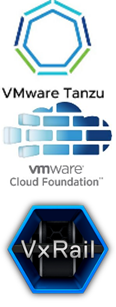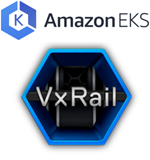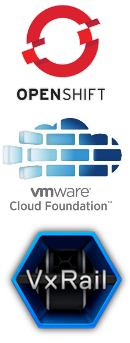Containing The Future With Dell EMC VxRail: Modern HCI Infrastructure for Running Container Orchestration Platforms
The world of containers is here, and it is driving business forward. Developers and infrastructure operators are designing, deploying, and integrating next-generation cloud native applications using a combination of containers and virtual machines (VMs), and taking advantage of the benefits that each delivers.
This evolution empowers customers to use their existing virtualization knowledge and extend it to containerized applications. Rather than develop siloed infrastructures that cater to individual workload types during this transition, many organizations are looking for a unified infrastructure platform that supports running both VMs and containers. This is where VxRail comes in.
The VxRail infrastructure is designed to run both VMs and containers. Regardless of the container orchestration platform, VxRail provides a scalable and life cycle-managed environment for consistently running containers across single or multicluster solutions. The simplicity of running container orchestration platforms on VxRail frees up organizations to focus on the business value and benefits that the solution delivers.
In recent years, a steady stream of performing validations and creating reference architectures for running containers on VxRail highlights the following:
- More customers are running container frameworks alongside—or even within—their virtualization frameworks, making for a smoother shift into the adoption of containers.
- Organizations are seeing VxRail as an ideal foundational infrastructure platform for quickly adopting containers and supporting their container orchestration runtime ecosystems of choice.
VxRail Hyperconverged Infrastructure (HCI) capabilities
VxRail Hyperconverged Infrastructure (HCI)-integrated systems help accelerate data center modernization, deploy hybrid clouds, and implement developer-ready application platforms based on Kubernetes (K8s). These tasks are possible as VxRail supports running the most demanding workloads and applications, whether VM-based or containerized while simplifying operations for IT infrastructure teams.
VxRail is the only fully integrated, preconfigured, and tested HCI system optimized for VMware. It delivers a seamless, automated operational experience with 100 percent native integration between VxRail Manager and vCenter. Intelligent life cycle management automates non-disruptive upgrades, updates, and node addition or retirement while keeping the VxRail infrastructure in a continuously validated state to ensure that workloads are always available.
These features make VxRail ideal for running container orchestration platforms, specifically those platforms that require vSphere for operation. As a result, VxRail provides customers with the flexibility to choose container orchestration platforms that are right for them. It enables them to run the container orchestration platform on a common HCI infrastructure platform that may be used with other traditional workloads.
Validating VxRail across container platform options
Dell Technologies helps customers accelerate their multicloud adoption and ensure that they have choices to select the best container orchestration platform. This flexibility has been confirmed through the development of a series of validation or reference architectures across several of the most widely adopted container orchestration platform distributions.
With VxRail, these containerized solutions deliver the same benefits on-premises or in the cloud. The following figure highlights some of these distribution options where validation work has been performed.
Figure 1. Examples of the container platforms options with VxRail
Let’s look at specific examples of running VxRail with some of today’s most commonly adopted orchestration platforms.
VMware Cloud Foundation with Tanzu on VxRail
VMware Tanzu enables businesses to build, run, and manage modern applications on any cloud and continuously deliver value to their customers. With VMware Tanzu, organizations can simplify multicloud operations and free up developers to move faster with easy access to the right resources. It also enables development and operation teams to work together to deliver transformative business results.

Figure 2.2
These capabilities start with the Tanzu Kubernetes Grid (TKG) runtime. With TKG, VMware uses the leading open-source technologies in the Kubernetes ecosystem to build a full Kubernetes runtime platform capable of running mission-critical customer applications.
TKG has the following open-source technologies, which VMware supports, built into its runtime platform for easy enterprise adoption:
- Cluster API for cluster life cycle management
- Harbor for container registry
- Contour for ingress
- Fluentbit for logging
- Grafana and Prometheus for monitoring
- Antrea and Calico for container networking
- Velero for backup and recovery
- Sonobuoy for conformance testing
With VMware Tanzu, businesses also have the flexibility for implementing the TKG runtime. They can do any of the following:
- Run TKG on any infrastructure, including vSphere, VMware Cloud on AWS, or native public clouds like AWS
- Run TKG in vSphere by using the TKG Service, which is bundled as a part of vSphere 7 with Tanzu and VMware Cloud Foundation (VCF) with Tanzu
- Run TKG as a service with Tanzu Mission Control (TMC)
Having touched on these TKG runtime implementation options, let’s look at the method used in our validated reference architecture: validating VMware Cloud Foundation with Tanzu on VxRail using the TKG Service. Why did we choose this method out of the three available methods? Because it delivers the type of easy deployment and operation that customers are looking for! VMware Cloud Foundation on VxRail delivers a simple and direct path to the hybrid cloud and Kubernetes at cloud-scale with one complete, automated platform.
The Reference Architecture document provides general design and deployment guidelines for running modern applications such as Confluent Kafka and Elasticsearch on VMware Cloud Foundation with Tanzu on VxRail. Find the Running Modern Applications with VMware Cloud Foundation with Tanzu on Dell EMC VxRail document here.
Amazon EKS Anywhere on VxRail
Amazon EKS Anywhere is a deployment option that enables customers to create and operate Kubernetes clusters on-premises using VMware vSphere, while allowing for connectivity and portability to AWS public cloud environments. It also provides operational consistency and tooling with AWS EKS.
Amazon EKS Anywhere on VxRail
Dell Technologies and Amazon recently validated Dell EMC VxRail running Amazon EKS Anywhere, in addition to the use of Dell EMC VxRail dynamic node clusters and Dell EMC PowerStore to provide the back-end storage for Amazon EKS Anywhere. (Dynamic nodes are not limited to this solution as they are features of VxRail and not specific to Amazon EKS Anywhere.)

VxRail is a strong platform choice for EKS Anywhere, which requires vSphere for production environments. EKS Anywhere running on VxRail delivers a seamless, automated operational experience for VxRail infrastructure across cloud-native and traditional workloads.
VxRail intelligent life cycle management automates non-disruptive upgrades and updates to keep its infrastructure in a continuously validated state, ensuring running workloads and optimized clusters. This automation greatly reduces risk so that customers can stay current with the multiple releases of Kubernetes and the EKS platform, which are updated using EKS Anywhere. VxRail and EKS Anywhere make it easy to standardize both IT and developer operations on-premises and in the Amazon public cloud.
EKS Anywhere is built on open-source software, using VMware vSphere to create and operate Kubernetes on-premises with automated deployment, scaling, and management of containerized applications. EKS Anywhere provides an installable software package for creating and operating on-premises Kubernetes clusters based on Amazon EKS Distro—the same Kubernetes distribution used by Amazon EKS for clusters on AWS.
By simplifying the creation and operation of on-premises Kubernetes clusters and automating cluster management, EKS Anywhere can reduce support costs and avoid the maintenance of redundant open-source and third-party tools. Using the EKS console also means viewing all Kubernetes clusters (including EKS Anywhere clusters) running through the EKS Connector (public preview).
Amazon EKS Anywhere is available by free download from AWS here. For more details, see the Running Amazon Elastic Kubernetes Service Anywhere on Dell EMC VxRail Solutions Brief here.
Red Hat OpenShift with VMware Cloud Foundation on VxRail
Red Hat OpenShift ships with Red Hat Enterprise Linux CoreOS for the Kubernetes control plane nodes. It supports both Red Hat Enterprise Linux CoreOS and Red Hat Enterprise Linux for worker nodes.
OpenShift supports the Open Container Initiative (OCI), an open governance structure for container formats and runtimes, including hundreds of fixes for defects, security, and performance issues for. 
Figure 4. OpenShift with VMware Cloud Foundation on VxRail
upstream Kubernetes in each release. It is tested with dozens of technologies as a tightly integrated platform supported over a nine-year life cycle. OpenShift includes software-defined networking, validates additional common networking solutions, and validates numerous storage and third-party plug-ins for its releases.
VMware Cloud Foundation on VxRail delivers flexible, consistent, secure infrastructure and operations across private and public clouds. It is well suited to meet the demands of modern applications running on Red Hat OpenShift Container Platform in a virtualized environment and makes it easy to manage the life cycle of the hybrid cloud environment. A unified management plane is also available for all applications, including OpenShift.
VMware Cloud Foundation uses leading virtualization technologies, including vSphere, NSX-T, and vSAN. VxRail Manager and VMware Cloud Foundation Manager provide the life cycle management, and vSAN provides reliable, high-performance, and flexible storage to OpenShift. NSX-T provides the secure, high-performance virtual networking infrastructure to OpenShift, and vSphere DRS and vSphere HA deliver efficient resource usage and high availability. All of these technologies combined to create a consolidated solution of running OpenShift Container Platform with VMware Cloud Foundation on VxRail.
The Running Red Hat OpenShift Container Platform on VMware Cloud Foundation Reference Architecture document, which demonstrates the architecture of running OpenShift Container Platform with VMware Cloud Foundation on VxRail, can be found here. This document shows the configuration details, hardware resources, and software resources used in the solution validation, along with various configuration options and best practices.
Conclusion
Dell Technologies and VMware continue to see containers as a high-value technology foundation for the future of enterprise solutions. While this blog post is heavily focused on containerization, keep in mind the significant and lasting role that virtualization continues to have in modern data centers. The importance of virtualization is especially true as not every workload is suited for containerization, meaning that containers complement virtualization while setting the foundation for building on the flexibility of containerized systems and platforms on VxRail.
